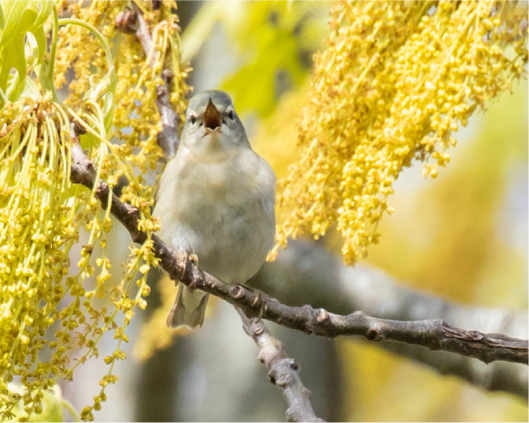Wayne R. Petersen

DAVID M. LARSON
The mystery species in this issue is more challenging than some other recent selections, and readers may find it advantageous to view the mystery photograph in color on the Bird Observer website. Regardless of how the image is viewed, however, several helpful aspects of the mystery bird are obvious. First, as indicated by its size compared to the oak flowers around it, the mystery species is a small bird, and the presence of these tree flowers indicates that the picture was likely taken in May. The bird appears to be singing, suggesting that it is a male, and it is possibly a warbler given its slim pointed bill and overall proportions, including a relatively short tail.
In the black-and-white image of the bird, its underparts are devoid of streaks, and in the online color version there's a slight blush of yellowish on the throat and upper breast. The color image also shows that the bird has a light gray cap and what appear to be whitish eye-arcs, a similarly colored supercilium, and the suggestion of a dark stripe through the eye. These features, combined with the bird's short tail and white undertail coverts, are most obvious in the color photo.
Although the back and wings are not visible in the picture, the collective impression is of a small, sharp-billed warbler with a plain throat, unstreaked underparts, a short tail, a gray cap contrasting with white eye-arcs, a pale supercilium, and a dark eye line. There are few eastern warblers with the combination of somewhat bland characteristics—especially in spring breeding plumage—shown by the mystery bird. Orange-crowned Warbler might be a possibility, but that species is generally drabber yellow below and typically has at least a hint of blurry olive streaks on the underparts and yellowish undertail coverts. Warbling and Philadelphia vireos are also similar in appearance to the mystery bird, but both vireos would possess a thicker bill with a tiny hook at the tip. In addition, a Warbling Vireo would have a plainer face without the suggestion of a gray cap, white eye-arcs, or dark eye line, and a Philadelphia Vireo would typically exhibit considerably more yellow on the throat and upper breast, have a less gray crown, show no suggestion of eye-arcs, and would generally show prominent dark lores. Having eliminated other possibilities, there is only one eastern warbler species that shares the features shown by the mystery bird—the Tennessee Warbler (Leiothlypis peregrina).
In Massachusetts, the Tennessee Warbler is an uncommon, canopy-loving warbler that, in May, is more often heard than well observed. In fall it is an inconspicuous migrant most frequently detected from mid-September to early October. Not unlike several other Canadian Zone nesting warblers, this species is more common in some years than others depending upon the abundance of spruce bud worms in the boreal forests where it nests. David Larson photographed this Tennessee Warbler in breeding plumage at the Parker River NWR on Plum Island, Massachusetts, on May 18, 2018.
Wayne R. Petersen